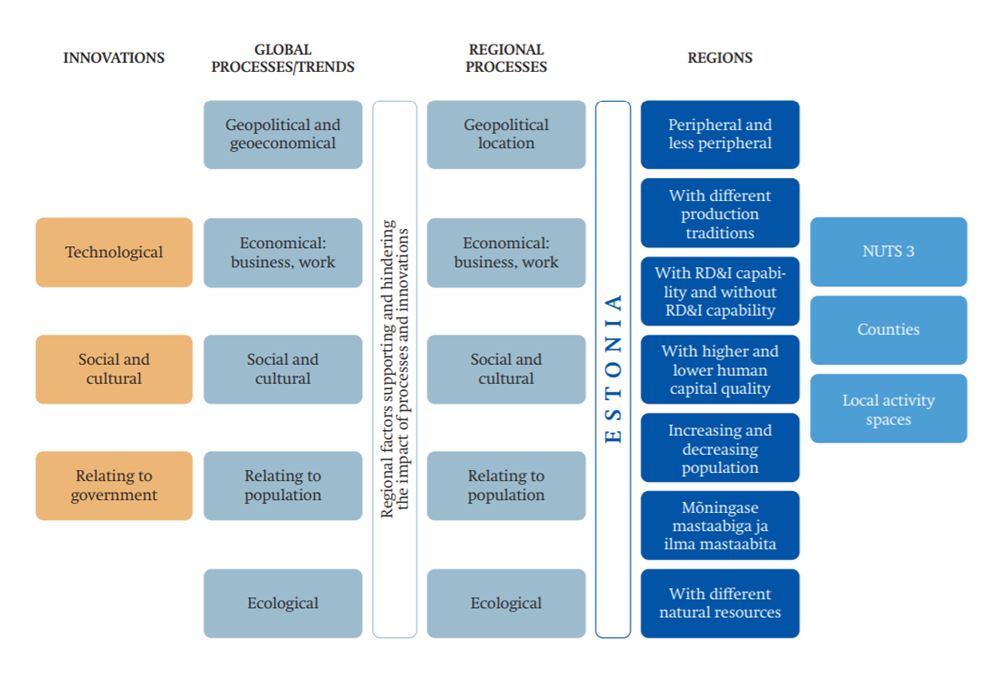The impact of innovations and socio-economic processes on the regional development in Estonia
The study presents an overview of key global innovations and processes, and describes their presumable regional impact in Estonia.
Five groups of innovations are outlined:
1. Infotechnological innovations: automatization and robotization of industries; artificial intelligence and machine learning; 5G internet; Internet of Things/Everything; analytics of big data; blockchain technologies; 3D printing; autonomous vehicles (incl drones); virtual reality.
2. Biotechnological innovations: genetic editing/engineering in agriculture, food industries and medicine; synthetic food; human enhancement; senolytics.
3. Innovations ion energy technology: smart grids; local energy systems; small-scale nuclear power plants; integrated solar moduls; hydrogen technologies; electric batteries and supercapacitors.
4. Social and cultural innovations: agile management; smart cities and communities; micro-manufacturing; personal medicine; place-based circular economy; life-long learning communities; social entrepreneurship; co-design of services.
5. Innovations in governance: multi-level governance; agile governance; regulative sandboxes; e-governance and e-services; the use big data in decision-making processes; knowledge based governance (incl. ex-ante evaluations; nudging); policy crowdsourcing.
These innovations make impact to regional development through socio-economic and ecological processes. Following major trends in key processes are determined:
1. Ecosystem trends: climate change/warming resulting in flooding of coastal areas, rising frequency of natural hazards; desertization; migration of fish-stocks to colder waters.
2. Population trends: increase of global migration (due to climate change, poor governance, poverty and inequality); polarization in urbanization processes – intensification along with urban shrinkage; aging of rich societies and social groups.
3. Cultural trends: strengthening of supranational identities; further segregation of information field; increase of significant policy actors; increase of nationalism and populism; trust problems towards „elites“, tensions within societies; e-services and digital gap; polarization of online and offline lives (slow living).
4. Trends in working life: demand based labor relations – employees and entrepreneurs; flexible work; increase of distance and home working (along with the development of ITC and VR technologies).
5. Geopolitical and geoeconomical trends: global multipolarity (China, G20, BRICS, MIKTA, EU, African Union, Arab League); private global actors; alternative models for Western liberal democracy; ambiguity in EU; rise of CEE within EU at the expense of Southern Europe; growth in demand concentrates in developing countries (esp. India, Africa); hindrance of growth in China.
6. Trends in governance: decentralization of governance – more power to regions and cities; privatization of services; increasing need for global rules and regulations (IP, digital rights and responsibilities, bioethics); primacy of ecological limits for sustainable development.
The analysis of regional impacts of global innovations and trends focuses on 6 key innovations
(automatization and robotization of industries; Internet of Things/Everything; 3D printing; autonomous vehicles; virtual reality; smart and local energy grids; place-based circular economy) and 4 processes (aging of population; flexible work; polarizing urbanization; climate change).
The report includes concise analytical descriptions of these innovations and processes, their probable impact on regional development, as well as factors making difference to how selected global innovations and processes influence Estonian regions.
Five types of regions are determined in Estonia, based on dominant settlement (urban or rural), degree of peripherality, location, degrees of scale, quality of human capital, density of R&D capacity and the existence of natural resources:
A. Wealthier urban regions, with some significant economies of scale and R&D capacities (Tallinn and Tartu urban regions, in perspective also Pärnu urban region);
B. Rural, agricultural region with traditional manufacturing industries (counties of the Central Estonia – Järva, Lääne-Viru, partially also Rapla, Jõgeva, Viljandi counties);
C. Industrial EU border region with carbon-intensive energy sector (Ida-Viru county);
D. Wood and forest border region with recreational resources (three counties of SouthEastern Estonia);
E. Sparsely populated marine and recreational Western Estonia.
The results of the analyze could by generalizing conclusion that adopting socio-technological innovations is much more probable and quicker in less peripheral regions with some scope and R&D capacities (A), while the potential positive impact of such innovations is more significant for peripheral sparsely populated regions (B, D and D). For the latter regions additional opportunities will be provided by the impact of some global trends to Estonian urban regions (A and C) – counterurbanization resulting from aging and cultural diversification, flexible working models and better technological opportunities for long distance work. Region C will be under highest pressure to reorient its economic structure in order to conform to global trends.

Author: Veiko Sepp, University of Tartu

 An independent think tank at the Riigikogu
An independent think tank at the Riigikogu